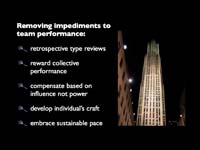I’ve written about agile software development as an ongoing, perhaps excruciatingly gradual, conversation on the definition of value.
We need a place at the conference table. But we also need a forum and language to discuss the human values behind the way we aspire to work.
“… I’ve got to have more experience with junior [children] than a lot of the people who are telling me what I should be doing with them… I think I could help bring a lot to it and nobody ever asks…They just go ahead and proclaim and we have to follow.” -– Anonymous Teacher
This quote is from a study on the failure of education reform movements, called What’s Worth Fighting for in Your School? , by Andy Hargreaves & Michael Fullan.
, by Andy Hargreaves & Michael Fullan.
Reform often fails because reformers don’t engage individual contributors in the goals. Rather, they impose practices upon them. The attempt to improve the classroom actually makes the teacher less effective and sets them against reform.
Sound familiar?
 The landscape of broken agile adoptions is composed of attempts to make software development “faster, cheaper, better” without embracing the experience and creativity of our core asset, the software developer.
The landscape of broken agile adoptions is composed of attempts to make software development “faster, cheaper, better” without embracing the experience and creativity of our core asset, the software developer.
We need to focus a little less on specific practices and a little more on building consensus among our peers over a shared set of values which despite human fallibility and economic necessity inspire us to do good work.
The Manifesto for Agile Software Development is an attempt by thought leaders to capture these principles. As with all documents, it is an artifact of a moment created to address that moment’s opportunities and constraints.
If we take the “Manifesto” as terms and conditions, something to read and sign before we advance to practice then we glide over the surface of things. It’s not what was written but why people felt the need to write it.
If we take the “Manifesto” as a complete expression, then as happens with codes of ethics, we will use its silence on certain concerns and nuance in the interpretation words themselves to excuse actions by others and even justify the harm we do ourselves.
The “Manifesto”, as with any other artifact in agile, is simply a reminder to have a conversation.
Martin Fowler discussing gender disparities in the industry:
How about a community where women are valued for their ability to program and not by the thickness of their skin? How about a community that edgily pushes new boundaries without reinforcing long running evils?
Bob Martin lobbying to add a fifth principle to the Manifesto itself:
“We value craftsmanship over execution” (or “craftsmanship over crap”)
But the discussion isn’t between thought leaders. It involves every practitioner.
We are here to create long-term value. To build businesses, careers and an industry. This is a labor of years not the current iteration.
If your concerns are entirely short term, then there are less disingenuous ways to extract wealth from people’s effort than to claim you are “agile”.
If you are agile, then you are accountable to the creativity and well-being of the teams with whom you collaborate. You are accountable for the security of end users and the benefit they derive from the software you create.
We are not tools. We are knowledge workers. What we create carries with it the way it was created. What we create is in some profound way us.










